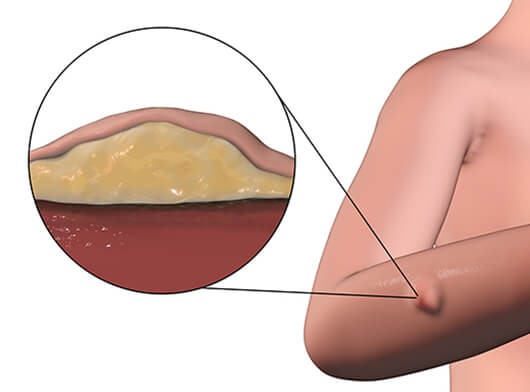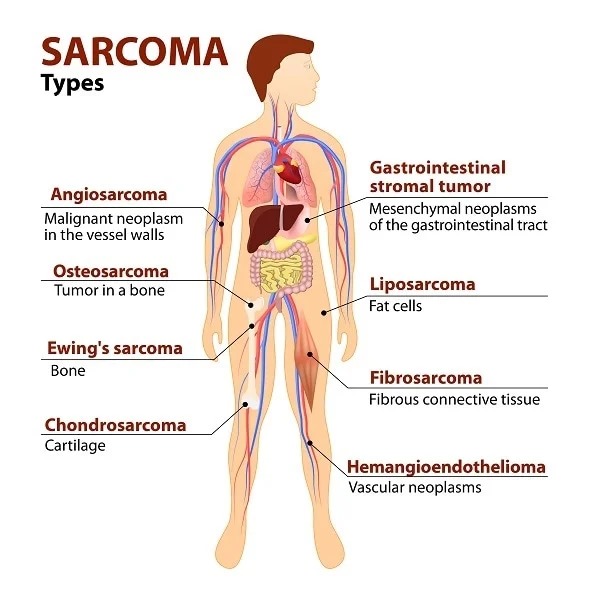
Dr. Waseem Abbas
Cancer Treatment Specialist
Director Research, Max Hospital, Shalimar Bagh
How to contact me
Max Superciality Hospital, FC 50, C and D Block, Shalimar Place Site, Shalimar Bagh, New Delhi, Delhi 110088
Phone: +91 98112 42729
Email: drabbasdoc@gmail.com
Search this website
Common Cancers in India
Get a free E-consultation about lung cancer immunotherapy in Delhi
Sarcoma

A sarcoma is a type of cancer that starts in tissues like bone or muscle. Bone and soft tissue sarcomas are the main types of sarcoma. Soft tissue sarcomas can develop in soft tissues like fat, muscle, nerves, fibrous tissues, blood vessels, or deep skin tissues. They can be found in any part of the body.
A sarcoma is a malignant (cancerous) tumor that develops in bone and/or soft tissue. Soft tissues support other body structures and include:
- Muscle.
- Fat.
- Tendons.
- Cartilage.
- Ligaments.
- Blood vessels.
- Nerves.
Sarcomas are rare, making up only 1% of all adult cancer diagnoses and about 15% of childhood cancer diagnoses. Approximately 16,000 sarcomas are diagnosed in the United States each year (around 4,000 bone sarcomas and approximately 13,000 soft tissue sarcomas).
Where are most sarcomas found?
Sarcomas can form in various parts of your body — anywhere from your head to your toes:
- 40% occur in your lower extremities (legs, ankles, feet).
- 15% occur in your upper extremities (shoulders, arms, wrists, hands).
- 30% occur in your trunk/chest wall/abdomen/pelvis.
- 15% occur in your head and neck.
What are the types of sarcoma?

Sarcoma refers to a large group of cancers in bone and/or soft tissue. There are more than 70 known subtypes of sarcoma.
Bone sarcomas
Primary bone sarcoma is cancer that starts in the bone. More than one-third of bone sarcomas are diagnosed in people younger than 35 years old. Many are diagnosed in children.
Types of primary bone sarcoma include:
- Osteosarcoma (most common).
- Chondrosarcoma.
- Chordoma.
- Ewing’s sarcoma.
- Fibrosarcoma.
- Unlike primary bone cancer, metastatic bone cancer starts in another location (such as an organ) and travels to the bone. This cancer comes in many forms, often traveling from your thyroid, lung, kidney, breast or prostate.
When cancer from a distant organ spreads to your skeleton, it can create structural problems in your bones that may cause pain and reduce functioning.
Soft tissue sarcomas
Soft tissue sarcomas begin in the muscle or other connective tissues of your body. Unlike bone sarcomas, most soft tissue sarcomas occur in adults. Certain types of sarcoma, such as rhabdomyosarcoma, are found mostly in children.
Types of soft tissue sarcomas include:
- Angiosarcoma.
- Desmoplastic small
- round cell tumors.
- Gastrointestinal stromal
- tumor (GIST).
- Leiomyosarcoma.
- Liposarcoma.
- Malignant peripheral
- nerve sheath tumor.
- Malignant schwannoma.
- Myxofibrosarcoma.
- Rhabdomyosarcoma.
- Synovial sarcoma.
- Undifferentiated pleomorphic sarcoma.
What are the symptoms of sarcoma?
Other sarcomas can cause long-lasting bone pain or swelling in your arm or leg that worsens at night. These changes may limit your movement.
Symptoms may include:
- A new lump that may or may not hurt.
- Pain in an extremity (arm/leg) or abdomen/pelvis.
- Trouble moving your arm or leg (a limp or limited range of motion).
- Unexplained weight loss.
Back pain. - Sarcoma shares s
What are the stages of sarcoma?
Cancer staging is used to better understand how serious a sarcoma is and what treatments may work best. Providers classify most sarcoma based on the TNM classification system:
T: Describes the size and location of the primary tumor.
N: Describes whether the cancer has spread to nearby lymph nodes.
M: Describes whether the cancer has spread to other organs (metastasized).
How are sarcomas treated?
Your treatment will depend on various factors, including:
- The type of sarcoma.
- Its size and location.
- Your general health.
- Whether the sarcoma is newly diagnosed or returned (recurrent).
- Surgery
- Radiation therapy
- Chemotherapy
- Targeted therapy
- Immunotherapy
What is the survival rate of sarcoma?
The five-year survival rate of soft tissue sarcoma ranges from 15% for metastasized cancer (cancer that has spread to other parts of your body) to 81% for cancer that hasn’t spread. The five-year survival rate for osteosarcoma (the most common type of bone cancer) ranges from 26% for metastasized cancer to 77% for cancer that hasn’t spread.
